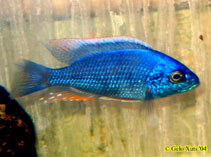| Family: |
Cichlidae (Cichlids), subfamily: Pseudocrenilabrinae |
| Max. size: |
11 cm TL (male/unsexed) |
| Environment: |
benthopelagic; freshwater; pH range: 7.30000019073486 - 8.30000019073486; dH range: 5 - 30 |
| Distribution: |
Africa: Endemic to Lake Malawi, occurring along the eastern shores between Chimwalani Reef and Gome Village. |
| Diagnosis: |
Diagnosis: 3 lateral spots on body; supra-pectoral spot about 1.5 times supra-anal spot; supra-pectoral spot in contact with upper lateral line; supra-anal spot separate from upper lateral line; no narrow black submarginal band in dorsal fin; breeding males with yellow breast, wide yellow marginal band in anal fin and white margin in dorsal fin; female C. verduyni cannot reliably be distinguished from those of C. trewavasae (Ref. 57549).
Description: dorsal snout profile straight to slightly convex in smaller individuals; gape inclination of mouth about 30° to horizontal; jaws isognathous; teeth on dentary and premaxilla in three rows, outer row teeth bicuspid in females and immatures but unequally bicuspid tending to unicuspid in mature males, inner rows teeth bicuspid in females and immature males but unicuspid in mature males; lower pharyngeal jaw small, dentigerous area notched posteriorly, with bicuspid teeth, all small, except posterior row slightly enlarged with few enlarged central teeth; gillrakers on ceratobranchial short and broad (Ref. 57549).
Coloration: breeding males: head dark blue with light-blue highlights; interorbital blue with green patches; upper and lower jaws green; throat blue/green; lateral portion of body blue dorsally fading to green/orange ventrally; anterior portion of scales orange; breast dark yellow; belly off white with orange and green highlights; dorsal fin blue with white marginal band; caudal fin with blue rays with micro-melanophores and orange membranes; anal fin with orange marginal band, membranes between spines blue; pectoral fin clear; pelvic fin black with white leading edge (Ref. 57549). Females: head gray dorsally, fading to white ventrally; throat white; lateral portion of body gray ground color dorsally fading to white ventrally with gold spot on anterior portion of each scale; supra-pectoral spot below 11-12th scale in contact with upper lateral line and about 1.5 times size of supra-anal spot; supra-anal spot at 22-23nd scale between upper and lower lateral line and covering 2-3 scales; caudal spot same diameter as supra-anal spot on caudal base extending onto peduncle; 2-3 vertical bars between supra-pectoral spot and dorsal-fin origin; dorsal fin clear with brown/orange vermiculations; caudal fin clear with orange/brown spots; anal fin clear with some black pigment in rays; pectoral fin clear; pelvic fin clear with micro-melanophores (Ref. 57549). |
| Biology: |
Lives in the sand/rock interface; among congeners, this species defends the least-visible spawning sites; most males defend spawning sites at depths of 9-15m; females and non-territorial males feed from the plankton in the water colmun 1-3m off the bottom and on benthic invertebrates (Ref. 57549). |
| IUCN Red List Status: |
Least Concern (LC); Date assessed: 22 June 2018 Ref. (130435)
|
| Threat to humans: |
harmless |
Source and more info: www.fishbase.org. For personal, classroom, and other internal use only. Not for publication.

